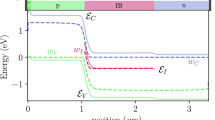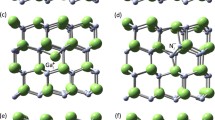Abstract
Electronic band structure is incorporated into a versatile energy transport model that treats heat flow between mobile electron ensembles with the thermodynamic identity for ideal gases instead of an electron thermal conductivity. This alleviates the closure issue common to thermal conductivity models and is amenable to different forms of charge gas transport. This flexibility allows the model to accommodate band dispersions typical of semiconductors. A simulation scheme and the device equations for a generalized band structure are presented. The model is then implemented for GaAs using a band structure calculated with the empirical pseudopotential method. Comparisons to Monte Carlo for certain bulk GaAs test cases indicate that the model may capture hot electron effects with sufficient accuracy and reduced computational cost suitable for larger scale device simulation and design.
Similar content being viewed by others
References
Fawcett, W., Boardman, A., Swain, S.: Monte Carlo determination of electron transport properties in gallium arsenide. J. Phys. Chem. Solids 31, 1963–1990 (1970)
Shichijo, H., Hess, K.: Band-structure-dependent transport and impact ionization in GaAs. Phys. Rev. B 23(8), 4197–4207 (1981)
Abramo, A., et al.: A comparison of numerical solutions of the Boltzmann transport equation for high-energy electron transport silicon. IEEE Trans. Electron Devices 23(9), 1646–1654 (1994)
Saraniti, M., Goodnick, S.: Hybrid fullband cellular automaton/Monte Carlo approach for fast simulation of charge transport in semiconductors. IEEE Trans. Electron Devices 47(10), 1909–1916 (2000)
Zhang, W., Du, G., Zhang, A., Mo, Z., Liu, X., Zhang, P.: A 3D parallel Monte Carlo simulator for semiconductor devices. IEEE Int. Workshop Comput. Electron. 1(1), 1–4 (2009)
Baraff, G.: Maximum anisotropy approximation for calculating electron distributions; application to high field transport in semiconductors. Phys. Rev. 133(1), 26–33 (1964)
Liang, W., Goldsman, N., Mayergoyz, I., Oldiges, P.: 2-D MOSFET modeling including surface effects and impact ionization by self-consistent solution of the Boltzmann. Poisson, and hole-continuity equations. IEEE Trans. Electron Devices 44(2), 257–267 (1997)
Vecchi, M., Mohring, J., Rudan, M.: An efficient solution scheme for the spherical-harmonics expansion of the Boltzmann transport equation. IEEE Trans. Comput.-Aided Des. Integr. Circuits Syst. 16(4), 353–361 (1997)
Gnudi, A., Ventura, D., Baccarani, G.: Two-dimensional MOSFET simulation by means of a multidimensional spherical harmonics expansion of the Boltzmann transport equation. Solid-State Electron. 36(4), 575–581 (1993)
Jungemann, C., Hong, S.M., Matz, G.: High-order spherical harmonics solution of the Boltzmann equation and noise modeling. Int. Workshop Comput. Electron. 1(1), 1–6 (2010)
Rupp, K., Jungel, A., Grasser, T.: Matrix compression for spherical harmonics expansions of the Boltzmann transport equation for semiconductors. J. Comput. Phys. 229(1), 8750–8765 (2010)
Grasser, T., Tang, T.W., Kosina, H., Selberherr, S.: A review of hydrodynamic and energy-transport models for semiconductor device simulation. Proc. IEEE 91(2), 251–274 (2003)
Grupen, M.: An alternative treatment of heat flow for charge transport in semiconductor devices. J. Appl. Phys. 106(1), 123702–123708 (2009)
Stratton, R.: Diffusion of hot and cold electrons in semiconductor barriers. Phys. Rev. 126(6), 2002–2014 (1962)
Trovato, M., Reggiani, L.: Maximum-entropy principle for static and dynamic high-field transport in semiconductors. Phys. Rev. B 73(1), 245209–245225 (2006)
Vasicek, M., Cervenka, J., Wagner, M., Karner, M., Grasser, T.: A 2D non-parabolic six-moments model. Solid-State Electron. 52(1), 1606–1609 (2008)
Kittel, C., Kroemer, H.: Thermal Physics (2nd ed.). Freeman, New York (1980)
Hess, K.: Advanced Theory of Semiconductor Devices. IEEE Press, Piscataway (2000)
Goano, M.: Algorithm 745: Computation of the complete and incomplete Fermi-Dirac integral. ACM Trans. Math. Softw. 21(3), 221–232 (1995)
Goano, M.: Series expansion of the Fermi-Dirac integral \({\mathcal{F}}_{j}(x)\) over the entire domain of real f and x. Solid-State Electron. 36(2), 217–221 (1993)
Scharfetter, D., Gummel, H.: Large-signal analysis of a silicon read diode oscillator. IEEE Trans. Electron Devices 16(1), 64–77 (1969)
Selberherr, S.: Analysis and Simulation of Semiconductor Devices. Springer, New York (1984)
Ridley, B.: Quantum Processes in Semiconductors (2nd ed.). Clarendon Press, Oxford (1988)
Ashcroft, N., Mermin, N.: Solid State Physics. Harcourt Brace, New York (1976)
Yu, P., Cardona, M.: Fundamentals of Semiconductors: Physics and Materials (3rd ed.). Springer, New York (2005)
Cohen, M., Bergstresser, T.: Band structures and pseudopotential form factors for fourteen semiconductors of the diamond and zincblende structures. Phys. Rev. 141(2), 789–796 (1966)
Harrison, P.: Quantum Wells, Wires, and Dots. Wiley, New York (2000)
Fischetti, M., Laux, S.: Monte Carlo analysis of electron transport in small semiconductor devices including band-structure and space-charge effects. Phys. Rev. B 38(14), 9721–9745 (1988)
Saraniti, M., Hu, Y., Goodnick, S., Wigger, S.: Overshoot velocity in ultra-broadband THz studies in GaAs and InP. Physica B 314(1), 162–165 (2002)
Sotoodeh, M., Khalid, A., Rezazadeh, A.: Empirical low-field mobility model for III–V compounds applicable in device simulation codes. J. Appl. Phys. 87(6), 2890–2900 (2000)
Shiktorov, P., Gruz̆inskis, V., Starikov, E., Reggiani, L., Varani, L.: Noise temperature of n + nn + GaAs structures. Phys. Rev. B 54(12), 8821–8832 (1996)
Silvester, P., Ferrari, R.: Finite Elements for Electrical Engineers (3rd ed.). Cambridge University Press, Cambridge (1996)
Author information
Authors and Affiliations
Corresponding author
Rights and permissions
About this article
Cite this article
Grupen, M. Energy transport model with full band structure for GaAs electronic devices. J Comput Electron 10, 271–290 (2011). https://doi.org/10.1007/s10825-011-0364-9
Published:
Issue Date:
DOI: https://doi.org/10.1007/s10825-011-0364-9




